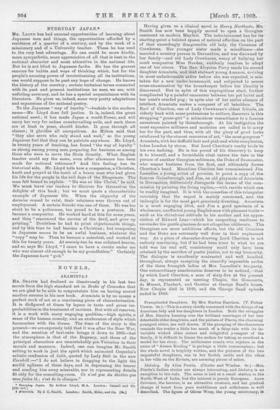NO ARAMINTA.t
Mn. SNAITR bad declined so disastrously in his last two novels from the high standard set in Broke of Covenden that we are glad to be able to congratulate him on having scored another success in his new book. Araminta is by no means a perfect work of art or a convincing piece of characterisation. It is disfigured at times by lapses in taste and gross im- probabilities in the treatment of incident. But with all reserves, it is a work with many engaging qualities,—high spirits, a sense of the human comedy, and an exuberance of style which harmonises with the theme. The time of the story is the present—we are expressly told that it was after the Boer War, and the mention of taxi-cabs brings it down to 1905—but the atmosphere is that of the Regency, and three of the principal characters are unmistakably pre-Victorian in their morals and manners. Indeed, one can imagine Mr. Snaith setting to work in just the spirit which animated Coquelin's artistic confession of faith, quoted by Lady Bell in the new Cornhill I do not believe in dragging to the light the sordid ugliness of these days, and in depressing the hearer and sending him away miserable, nor in representing details fit only for the consulting-room. Ce tied pas du theilire que vans faites ; c'est de la clinique."
• .goerpday Japan. By Arthur Lloyd, M.A. London: Cassell and Co. [12e, net.] • Araminta. Dy J. CI. atatitb. London: Smith, Elder, and CO. NO Having given us a clinical novel in Henry Northeote, Mr. Snaith has now been happily moved to open a Georgian casement on modern Mayfair. The entertainment has for its starting-point a belated spasm of natural affection On the part of that exceedingly disagreeable old lady, the Countess of Crewkerne. Her younger sister made a mesalliance—she married a country parson in Devonshire, and was disowned by her family—and old Lady Crewkerne, weary of bullying her meek companion Miss Burden, suddenly resolves to adopt one of her nieces. The Rev. Aloysius Perry sends his second daughter Araminta, and that stalwart young Amazon, arriving in. most unfashionable attire before she was expected, is Dais- taken for a new under-housemaid, and subjected to severe cross-examination by the housekeeper before her identity is discovered. But in spite of this unpropitious start, further complicated by a painful encounter between her pet ferret and her aunt's overfed pug; in spite also of her entire absence of intellect, Araminta makes a conquest of all beholders. The Earl of Cheriton, one of Lady Crewkerne's oldest friends, an elderly buck with some pretensions to culture, discovers in this strapping " goose-girl" a miraculous resemblance to a famous ancestress painted by Gainsborough. At his instigation the most expensive milliners and modistes are called in to array her for the part, and thus, with all the glory of good looks reinforced by the utmost resources of art, "the most gorgeous" Aratninta, with her daffodil hair and pink and white complexion, takes London by storm. But Lord Cheriton's vanity leads to his own undoing. He is too proud of his discovery to keep it to himself, and a formidable rival enters the lists in the person of another Georgian nobleman, the Duke of Brancaster, who means business from the first, and ultimately forces Cheriton's hand. Meantime Cheriton has commissioned Jim. Luscelles, a young artist of promise, to paint a copy of the famous Gainshorough, and Jim, an old playmate of Aratninta in Devonshire, deliberately disregards the terms of the corn- mission by painting the living replica,—with results which can be readily imagined. It is with the comedies of this triangular courtship that the sequel is mainly concerned, and the imbroglio is for the most yart genuinely diverting. Araminta is a most engaging idiot, and Jim a good specimen of a wholesome, unaffected young Englishman with pleasant traits— sue!: as his chivalrous attitude to his mother and his appre- ciation of Edward Lear—which his unsporting readiness to surrender the gentle giantess do not altogether obliterate. The Georgians are more ambitious efforts, but the old Countess and the Duke are extremely well done in their unpleasant way. As a piece of character-drawing Lord Oheriton is not entirely convincing, but if he had been truer to what we are told was his real self, consistency could only have been attained by the sacrifice of poetic justice, not to say humanity. The dialogue is excellently contrasted and well handled throughout, always excepting the absurdly impossible asides of the three frumpish ladies at Mrs. Laticelles's tea-party. One extraordinary anachronism deserves to be noticed,—that by which Lord Cheriton, a man of sixty-five at the present day, is represented as meeting Chopin, the Goncoarte, de Musset, Flaubert, and Gautier at George Sand's house. Now Chopin died in 1849, and the George Saud episode ended in 1843.










































 Previous page
Previous page